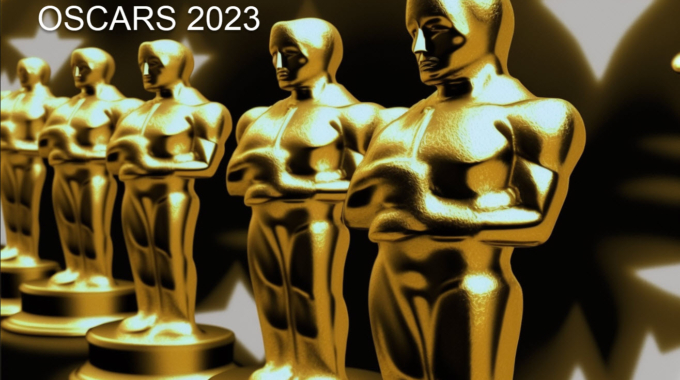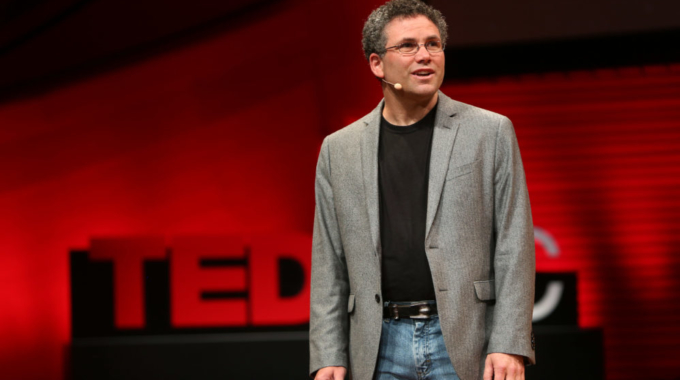
Dr Louis Rosenberg effectively created the concept of augmented reality and set up one of the world’s first virtual reality companies. Now he’s turned his attention to artificial intelligence with his latest business Unanimous AI. He sat down with Dan Robinson of Compelo to explain how it could have a huge impact on sports betting, financial markets and healthcare – while protecting jobs through “amplifying” human intelligence

Read the profile HERE
From COMPELO by Dan Robinson:
Some of the most beautiful photographs in nature show birds, bees and fish travelling in swarms.
But they’re not just putting on a show for the photographers, for these animals make better decisions when they pool their resources and minds.
This was the starting point for Dr Louis Rosenberg and his team at Unanimous AI when he put forward the theory that humans too could improve their choices and conclusions as a collective.
Already, the results are proving him right as Swarm AI, the Californian start-up’s artificial intelligence system, is using algorithms to assess collective human insights to make more accurate predictions in sports betting, financial markets and healthcare.
Sitting across the table in a London café after unveiling one of the company’s latest studies at the University of Cambridge, Dr Rosenberg speaks of “amplifying the intelligence of people” by combining their collective insights with AI.
“There’s an old saying that two heads are better than one. So imagine how smart 20 heads could be, or 200,” says the 49-year-old.
“Now imagine that the knowledge, wisdom, insights, and intuition of hundreds of people are connected by AI algorithms, producing an emergent intelligence that can ‘think together’ as a super-expert. That’s what we do at Unanimous AI, and it works.
“We’ve done studies where people can be significantly more accurate in the price of gold, oil or stock market predictions.
“In medicine, instead of calling it a forecast, we call it a diagnoses but it’s essentially the same thing.”
From AR and VR to Unanimous AI
AI is just the latest futuristic technology Dr Rosenberg is getting to grips with, having also been a pioneer in virtual reality (VR) and augmented reality (AR) – but more on that later.
After selling his VR business Immersion in 2002, he took to studying and teaching, focusing his doctoral work for a PhD at Stanford University on robotics, VR and human-computer systems.
Unanimous AI was founded in 2014 to pursue his tech interests – but with a new remit.
“I’ve spent all my career looking at ways to use tech to allow people to perform better,” he says.
“When I left Immersion, I began to think about other interesting ways I could amplify human performance.
“While I was teaching at California Polytechnic State University, I realised that while it’s really interesting to look at how technology can increase the performance of an individual, what can it do for groups?
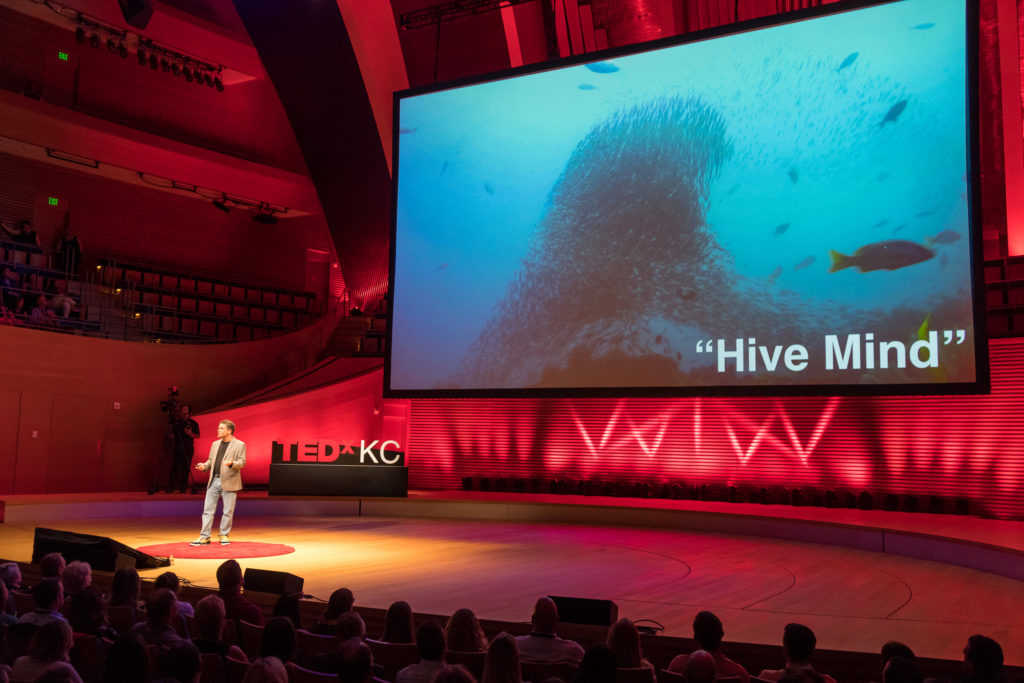
Unanimous AI Dr Louis Rosenberg is a pioneer in the fields of virtual reality, augmented reality and artificial intelligence
“That’s when I realised there’s a whole new frontier of technology. How can we connect people together using AI and other technologies to allow them to be smarter in groups?”
It was at this point that Dr Rosenberg took a step back to look for other examples in the world of groups that become smarter together. He didn’t need to look far.
“Nature is the best example,” he says. “It’s been trying to solve problems for hundreds of years and is something biologists have been studying for decades.
“It’s called swarm intelligence. Birds are smarter together than when they’re alone. Groups of organisms can make significantly better decisions when thinking together in a system.
“A school of fish and a swarm of bees make incredibly accurate decisions as a group, so if they can get smarter together then why can’t humans do it?
“That was the inspiration to start Swarm AI – building technology to allow groups of people to connect over the internet and reach decisions the way nature does.”
Unanimous AI takes on Las Vegas betting markets
Over the past four years, Dr Rosenberg and his 24-strong Unanimous AI team – which has raised more than $5m (£3.8m) in venture capital funding and has offices in San Francisco, Chicago, Washington, DC and San Luis Obispo, California – has developed the Swarm AI technology and tested it in a number of arenas.
Sport has been an ideal frontier for studies because predictions are very quickly verifiable when pitching swarms of people against bookmakers.
Last month, the start-up published results from an experiment in which forecasts for 200 of America’s National Hockey League (NHL) games were made by the Swarm AI programme over a 20-week stint during the 2017/18 season.
About 30 regular sports fans took part by making predictions each week from their homes using an internet platform.
The AI bot used algorithms to detect not only the forecasts made by the participants, but the varying degrees of certainty each person had for individual games in order to reach a consensus from the “swarm”.
In total, Swarm AI was accurate in predicting 61% of winners. In comparison, the Las Vegas betting markets – which use human experts as odds-makers, and then shift odds according to the public’s betting behaviour – recorded 55% accuracy for the same games.
Dr Rosenberg says: “It’s very, very difficult to beat the Vegas odds. Very few individual gamblers can do it consistently over time.
“But by taking 30 ordinary people and thinking in a swarm, they beat Vegas over 200 games – and that’s pretty remarkable.”
Across the pond, Unanimous AI worked with the University of Oxford and 50 football fans to predict 50 English Premier League games over a five-week period last season.
Given that games can end in a win, loss or draw for teams, this was more difficult than the NHL, where matches can’t end in a tie.
Individuals who took part in the study were accurate on average 55% of the time, but as a swarm they achieved a 75% hit rate.
Predictions have continued this season, with results published on the Unanimous AI website, while the company is in discussions with betting companies to monetise its tech.
Explaining how the Swarm AI programme works, Dr Rosenberg likens it to a “tug of war” in which everyone participates at the same time on a shared visual interface that connects them together.
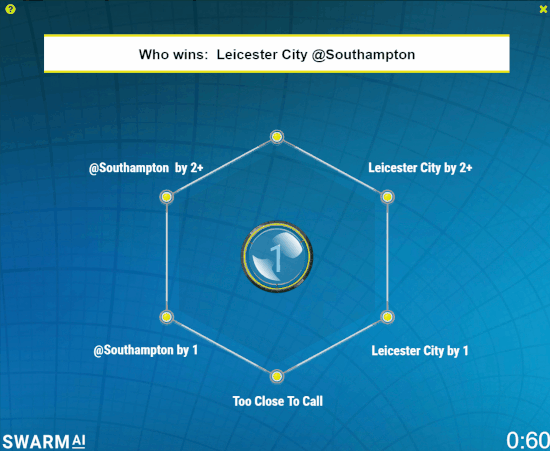
An example of Unanimous AI’s Swarm AI programme being used alongside human insights to predict an English Premier League game between Leicester City and Southampton in 2017/18. Leicester won 2-1
“Thirty people are pulling and pushing at the same time using their smartphone or touchscreen,” he says.
“The AI algorithms are watching the people as they’re doing that and reaching an answer.
“By looking at their behaviour, it looks at which people have conviction and those who aren’t sure.
“In one game you might be really certain who’s going to win, but in another you aren’t too sure.
“The AI system is able to determine their relevant levels of confidence to reach the best average results of everyone’s perspectives.
“It’s not going to be perfect but it’s going to be the best forecast that those people could have got from their insights.”
It’s not just sport where Unanimous AI could have an impact – but healthcare too
The Swarm AI programme has also been used in studies to predict financial markets, while 50 movie fans put their heads together to achieve a 94% success rate at the 2018 Oscars – outperforming major film critics from titles including The New York Times, Hollywood Reporterand Los Angeles Times.
Individually, the average success rate for the participants was significantly lower at 67% accuracy.
And while this presents clear commercial opportunities – Unanimous AI could help companies make sales or strategic forecasts, for example – perhaps the biggest difference it could make is in healthcare.
Dr Rosenberg’s eyes light up when he tells of his start-up’s latest study alongside Stanford University Medical School.
It showed how a group of seven radiologists – significantly fewer than the other tests – could work together as a “hive mind” to achieve higher accuracy in diagnosing chest X-rays for pneumonia than they could individually or using machine learning algorithms alone.
In the US, chest X-rays are one of the most widely performed imaging procedures and more than one million adults are hospitalised with pneumonia each year.
But diagnosing X-rays is highly challenging with significant variability across doctors, making it an important problem to solve for the medical community.
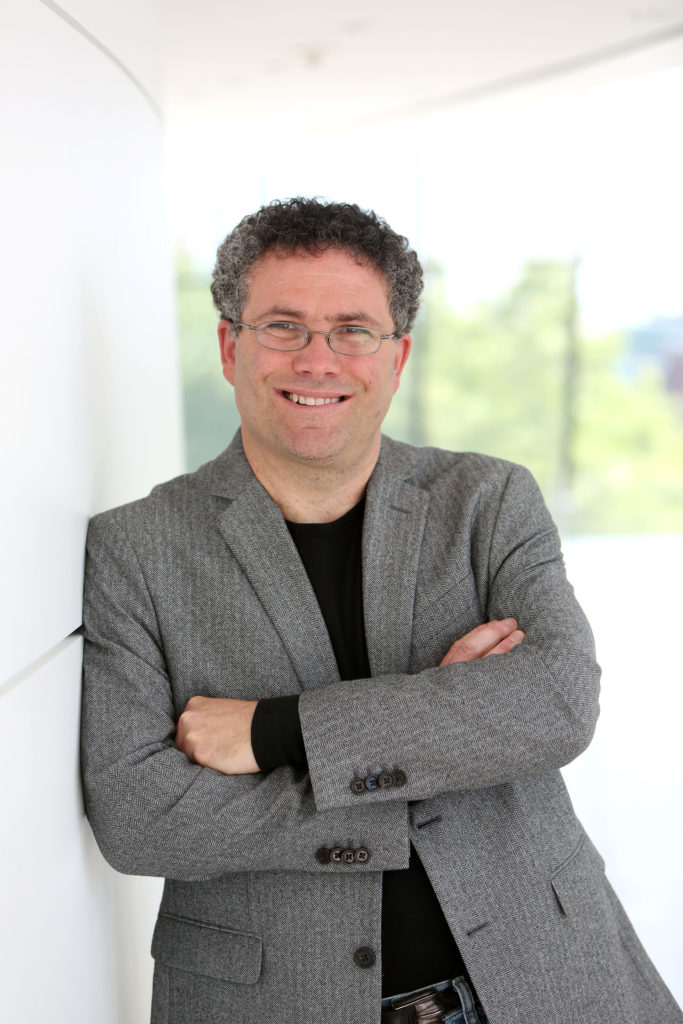
The research presented at last month’s SIIM Conference on Machine Intelligence in Medical Imaging, held in San Francisco, showed the error rate was reduced by 33% compared to traditional diagnoses by individual practitioners.
The Swarm AI system was also 22% more accurate than Stanford University’ CheXNet software, which made headlines last year for significantly outperforming doctors using deep-learning derived algorithms.
Dr Matthew Lungren, assistant professor of radiology at Stanford, called the results “very exciting” and believes it paves the way for a future “where doctors and AI algorithms can work together in real-time, rather than human practitioners being replaced by automated algorithms”.
This is a crucial point for Dr Rosenberg. While doom-mongers predict a tide of unemployment resulting from AI in the future, he says the X-ray study demonstrates how “humans-in-the-loop add real value”.
“We fundamentally believe that human wisdom, knowledge and experience should never be fully replaced from critical decisions,” he adds.
“In medicine, radiologists are the most terrified of AI because the CheXNet study showed machine learning can be more accurate in diagnoses without humans.
“But our study shows how radiologists can perform better than CheXNet as a system, which shows how humans can stay relevant in the job market.”
How Dr Louis Rosenberg helped get Shrek on the big screen
Prior to Unanimous AI, Dr Rosenberg had spent 20 years working in AR and VR.
Arguably his main claim to fame is for creating AR – long before the concept got its name – when he developed the virtual fixtures system for the US Air Force while studying for his PhD in 1992.
Featuring an overlay of augmented sensory information upon a user’s perception of a real environment, its function was to help humans remotely control robots more accurately.
“It was the first experience of when people had a combination of the real world and these virtual overlays that people could see,” recalls Dr Rosenberg with a smile.
He was on the road to entrepreneurialism a year later when he established VR company Immersion Corporation.
It was the first VR company to go public in 1999 and was sold in 2002, but still exists today in the Silicon Valley as a developer of haptic technology – which brings the sense of touch to digital content.
Next there was Microscribe, which afforded him to play a pivotal role in the production of major animated films.
The start-up developed the first desktop 3D digitiser, a portable robotic arm that enabled physical objects to be replicated as 3D computer models by tracing over the contours of clay models.
The Microscribe 3D digitiser was used to bring characters to life in films including Shrek, Ice Age, A Bug’s Life and Titanic, as well as video games such as Area 51.
“We originally made it for VR but it ended up being used in movies and we had a big customer base,” says Dr Rosenberg.
That company was sold too – as was his other business, AR tech developer Outland Research – before he embarked on a teaching career at California Polytechnic State University and eventually led him to setting up Unanimous AI.
He admits this one is the “most fun” yet, while it may well also have the greatest potential.
“I think it could become a unicorn,” he says without a hint of fear. “At the moment we’re at the stage of proving the different markets but the value could become very high, very quickly.
“But it also has great potential for doing something good in the world, particularly in medicine where we can get better patient outcomes and reduce costs by making diagnoses more accurate.
“We keep advancing the technology and our goal is to make the system smarter. My view is that AI is still in a very early stage and there’s a long way to go in terms of amplifying the intelligence of people.
“Rather than 30 people taking part, what about having 30,000? Can we get these super-accurate forecasts? Just how far can this technology evolve?”
About Unanimous AI:
Unanimous AI is a Silicon Valley company that has pioneered Swarm AI® technology, a new form of AI that combines real-time human insights and AI algorithms modeled after natural swarms. In 2018, Swarm AI technology won “AI Innovation of the Year” at the SXSW Innovation Awards. For more on Unanimous, visit http://unanimous.ai
Want to learn more about our Swarm AI technology? Check out our TED talk below…


